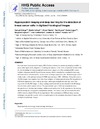Identificador persistente para citar o vincular este elemento:
https://accedacris.ulpgc.es/jspui/handle/10553/73413
| Título: | Hyperspectral imaging and deep learning for the detection of breast cancer cells in digitized histological images | Autores/as: | Ortega Sarmiento, Samuel Halicek, Martin Fabelo Gómez, Himar Antonio Guerra Hernández, Raúl Celestino López, Carlos Lejeune, Marylene Godtliebsen, Fred Marrero Callicó, Gustavo Iván Fei, Baowei |
Clasificación UNESCO: | 3314 Tecnología médica | Palabras clave: | Deep Learning Histological Hyperspectral Microscopy |
Fecha de publicación: | 2020 | Editor/a: | The international society for optics and photonics (SPIE) | Proyectos: | Identificación Hiperespectral de Tumores Cerebrales (Ithaca) | Publicación seriada: | Progress in Biomedical Optics and Imaging - Proceedings of SPIE | Conferencia: | Medical Imaging 2020: Digital Pathology | Resumen: | © 2020 SPIE. All rights reserved.In recent years, hyperspectral imaging (HSI) has been shown as a promising imaging modality to assist pathologists in the diagnosis of histological samples. In this work, we present the use of HSI for discriminating between normal and tumor breast cancer cells. Our customized HSI system includes a hyperspectral (HS) push-broom camera, which is attached to a standard microscope, and home-made software system for the control of image acquisition. Our HS microscopic system works in the visible and near-infrared (VNIR) spectral range (400 - 1000 nm). Using this system, 112 HS images were captured from histologic samples of human patients using 20× magnification. Cell-level annotations were made by an expert pathologist in digitized slides and were then registered with the HS images. A deep learning neural network was developed for the HS image classification, which consists of nine 2D convolutional layers. Different experiments were designed to split the data into training, validation and testing sets. In all experiments, the training and the testing set correspond to independent patients. The results show an area under the curve (AUCs) of more than 0.89 for all the experiments. The combination of HSI and deep learning techniques can provide a useful tool to aid pathologists in the automatic detection of cancer cells on digitized pathologic images. | URI: | https://accedacris.ulpgc.es/handle/10553/73413 | ISBN: | 9781510634077 | ISSN: | 1605-7422 | DOI: | 10.1117/12.2548609 | Fuente: | Proceedings SPIE The International Society for Optical Engineering [EISSN 2410-90451], n. 11320: 113200V |
| Colección: | Actas de congresos |
Citas SCOPUSTM
43
actualizado el 08-jun-2025
Citas de WEB OF SCIENCETM
Citations
31
actualizado el 08-jun-2025
Visitas
213
actualizado el 15-mar-2025
Descargas
272
actualizado el 15-mar-2025
Google ScholarTM
Verifica
Altmetric
Comparte
Exporta metadatos
Los elementos en ULPGC accedaCRIS están protegidos por derechos de autor con todos los derechos reservados, a menos que se indique lo contrario.
